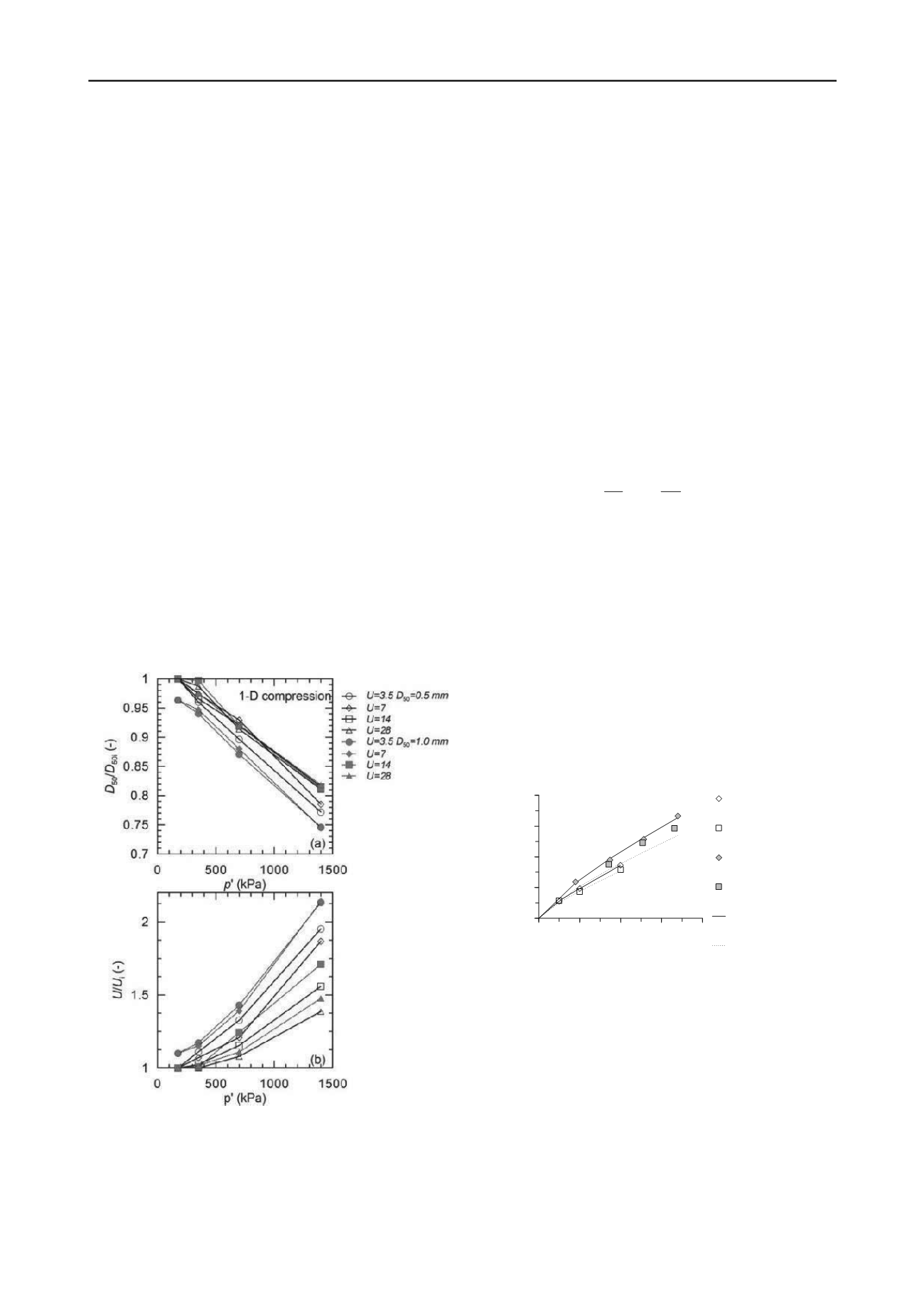
196
Proceedings of the 18
th
International Conference on Soil Mechanics and Geotechnical Engineering, Paris 2013
Proceedings of the 18
th
International Conference on Soil Mechanics and Geotechnical Engineering, Paris 2013
0.0
0.2
0.4
0.6
0.8
0.0 0.2 0.4 0.6 0.8
Normal stress (MPa)
Shear stress (MPa)
CP1
CP2
STV1: dmax=40mm
STV2: dmax=160mm
De Mello's fitting
Prediction for CP2 &
STV2
The problem of estimation of the at rest coefficient K
o
for
overconsolidated soils is treated by Bohac et al. (2013). At a site
containing highly overconsolidated clays, K
o
was measured by
using Marchetti (1980) flat dilatometer. The K
o
values are
higher than those estimated from oedometer yield point and
empirical correlations by Main and Kulhawy (1982). Numerical
modelling of the flat dilatometer penetration into the soil based
on a
hypoplastic model (Mašín, 2005)
combined with the
intergranular strain concept proposed by Niemunis and Herle
(1997) were also performed. However the K
0
values are slightly
underpredicted.
5 CRUSHABLE GRANULAR SOILS
The significance of particle crushing to the mechanical
behaviour of granular materials has been well identified and in
the particular field of geomechanics, it is recognized as having a
major effect in a wide range of practical problems involving
shallow foundations, bearing capacity of piles, stability of earth
structures, seepage properties, hydraulic conductivity, and pore-
pressures distribution in earth dam water retaining structures,
pavement and railway substructures. However, the laboratory
investigation and interpretation of crushable materials show
some inherent difficulties and there is a need for consideration
of appropriate approaches that may differs from non-crushable,
cohesionless sands. In this respect, Wils et al. (2013) identify
and analyse several issues like: determination of the minimum
and maximum density, sieving and the need for advanced grain
morphology characterisation by means of microscopy, the
abrasion of particles and the apparent cohesion due to
interlocking of the angular particles creating sand clusters with
the appearance of larger particles, as well as the existence of
larger shells sheltering smaller grains.
Figure 14. Evolution of ratios: (a)
d
50
/
d
50i
and (b)
U
/
U
i
with mean
effective stress applied in 1D-compression (Casini et al. 2013).
An experimental investigation into the mechanical response
of an artificial granular material, consisting of crushed
expanded clay pellets, LECA (Light Expanded Clay Aggregate)
under various stress path tests is conducted by Casini et al.
(2013). The material was reconstituted, with a maximum
particle size of 2 mm, into grading curves with the same mean
diameter, d
50
, and different coefficients of uniformity, U (= 3.5,
7, 14, 28) or the same U and different d
50
(= 0.5, 1mm).
Changes in of the grading at the end of the tests (one
dimensional, isotropic and triaxial compression) were described
using two parameters defined as the mean diameter and
coefficient of uniformity of the final distribution over the values
of the initial distributions,
d
50
/
d
50i
and
U
/
U
i
, respectively. Poorly
graded samples show more pronounced decrease in mean
diameter and increase of uniformity with higher applied stresses
(Figure 14).
Experimental evidence of size effects in rockfill shear
strength and the link with the crushing strength of rock
aggregates is presented by Frossard et al. (2013). Compression
test results on individual chalk (CP) and quartz rock (STV)
particles have been statistically analysed and it was shown that
the probability of survival for each grain size fraction follows
Weibull distribution given by:
(3)
where
o
is the value of the strength of d
o
size particles such
that 37% of the total number of tested particles survive. The
exponent m is called the Weibull modulus, which increases with
decreasing variability in strength of the material. For each
material, drained triaxial tests on dry samples (maximum
particle diameter sizes of 40mm (CP1 and STV1) and 160mm
(CP2 and SV2)) under different confining presures were
performed. Considering that individual particle breakages affect
the shear strength of the entire granular medium, a method to
predict the effects of scale on shear strength envelopes of
rockfills is proposed. Figure 15 shows the comparison between
measurements and predictions for shear strength envelopes for
both CP2 and STV2 materials, based on the best fit of CP1 and
STV1 data with the failure envelope given by De Mello (1977)
(
=A.
n
b
).
Figure 16. Scale effect on shear strength (Frossard et al. 2013).
Investigations performed by Shahnazari et al. (2013) on the
mechanical behaviour in triaxial apparatus of two calcareous
natural soils obtained from the Persian Gulf, Hormuz Island
sand (HI) and Bushehr Port sand (BP) (Figure 16), and
comparison with the triaxial response of a silica sand, Firoozkuh
(F) showed behavioural contrast between the sand materials,
and through global measurements, clear evidence of particle
breakage of the former soils.
Results from a series of basic characterisation tests
conducted on reconstituted samples of carbonate sand to
understand its behaviour are reported by Safinus et al. (2013).
Compared to silica sand, carbonate sand has considerably
higher angularity, lower grain hardness and higher intra-particle
m
o
n
o
s
d
d
d
dP
exp


